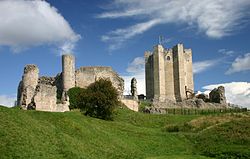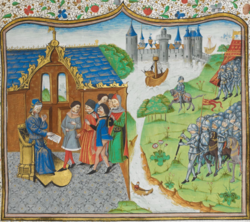
As the third daughter of Peter the Cruel of Castile and his long-term mistress (and sometime wife) Maria of Padilla, Isabella of Castile‘s childhood was marred by her father’s battles to hold on to his throne and almost constant warfare with Aragon.
Peter was known in some areas as Peter the Cruel and in others as Peter the Just, depending which side of the conflict people were on. He received support from Edward III of England’s eldest son and heir Edward, the Black Prince, but Peter’s failure to pay the costs of the prince’s campaign, his faithlessness, and the failing health of the Black Prince, meant the king of Castile was left to his own devices by 1367. Adding to Peter’s woes, his own nobles backed the king’s illegitimate brother, Henry of Tastamara, as an alternative candidate. Henry eventually defeated and killed Peter in March 1369.
Isabella’s mother had died in 1361 and her 3-year-old brother, Alfonso, in 1362. On Peter’s death, Isabella’s older sister, Constance, inherited their father’s claim to the crown of Castile, but was unable to pursue this claim. This situation in Castile was precarious, to say the least. Taking Isabella with her, the two princesses took refuge in the English territory of Guyenne. The English took the princesses in and soon after, in September 1371, Constance was married to John of Gaunt, the third surviving son of Edward III, at Roquefort. John of Gaunt had become duke of Lancaster on marrying his first wife, Blanche of Lancaster, who had died in 1368; saw this second marriage as an opportunity to gain a kingdom of his own. When the newly married couple returned to London, they brought Constance’s sister, Isabella, with them.
Following Constance’s official entry into London, Isabella married John’s younger brother, Edmund of Langley, the fifth son of Edward III, on 11 July 1372, at Wallingford. In marrying Isabella, Edmund was likely following his father’s instructions, in pursuit of the English policy of the time, to reinforce the dynastic link between England and Castile and thus ensuring that both heirs of Peter of Castile were married into the English royal line. On her marriage to Edmund, Isabella became Countess of Cambridge, and would become the first ever Duchess of York when Edmund was created Duke of York by his nephew, King Richard II, on 6 August 1385. She was appointed a Lady of the Garter in 1379.
The couple’s first son, Edward was born the following year – he would become the second Duke of York, and be killed at Agincourt in 1415. A daughter, Constance, was born in 1374.
Chroniclers of the time reported that Isabella and Edmund were an ill-matched pair; Thomas of Walsingham, in particular, commented on Isabella’s ‘loose morals’, probably referring to her not-so-secret affair with John Holland, Duke of Exeter and half-brother to the king, Richard II. The affair is believed to have started as early as 1374 and has cast doubt on the legitimacy of Edmund and Isabella’s third and youngest child, Richard of Conisbrough. Richard, grandfather of both Edward IV and Richard III, was born at Conisbrough Castle in Yorkshire, sometime between 1375 and 1386. He was executed for his involvement in the Southampton Plot, against Henry V, in 1415.

Isabella died on 23rd December 1392, aged about 37, and was buried at the church of the Dominicans, in King’s Langley, on 14 January 1393. In her will, she made Richard II her heir and asked that he provide a pension for her youngest son and Richard II’s godson, Richard of Conisbrough. Richard was given an allowance of £500 by the king, but this was only paid sporadically following Richard II’s deposition by Henry IV.
Richard was not even mentioned in the wills of his father and brother and G.L. Harriss, of the Oxford Dictionary of National Biography, has speculated this could be proof that Richard was not the son of the Duke of York.
Edmund married again, to his cousin Joan Holland, niece of his first wife’s lover, John Holland. In another bizarre family twist, it was Joan’s brother, Edmund Holland, 4th Earl of Kent, who had an affair – and an illegitimate daughter – with Constance of York, the daughter of Edmund and Isabella.
*
Sources: Ian Mortimer, Edward III The Perfect King; englishmonarchs.co.uk; womenshistory.about.com; History Today Companion to British History; WM Ormrod, The Reign of Edward III; Conisbrough Castle, South Yorkshire; Oxforddnb.com.
Photos from Wikipedia, except Conisbrough Castle which is © Sharon Bennett Connolly.
*
My Books
Signed, dedicated copies of all my books are available, please get in touch by completing the contact me form.
Defenders of the Norman Crown: The Rise and Fall of the Warenne Earls of Surrey tells the fascinating story of the Warenne dynasty, of the successes and failures of one of the most powerful families in England, from its origins in Normandy, through the Conquest, Magna Carta, the wars and marriages that led to its ultimate demise in the reign of Edward III. Defenders of the Norman Crown: Rise and Fall of the Warenne Earls of Surrey is now available from Pen & Sword Books, Amazon in the UK and US and Book Depository.
1 family. 8 earls. 300 years of English history!
Also by Sharon Bennett Connolly:
Ladies of Magna Carta: Women of Influence in Thirteenth Century England looks into the relationships of the various noble families of the 13th century, and how they were affected by the Barons’ Wars, Magna Carta and its aftermath; the bonds that were formed and those that were broken. It is now available in paperback and hardback from Pen & Sword, Amazon and from Book Depository worldwide.
Heroines of the Medieval World tells the stories of some of the most remarkable women from Medieval history, from Eleanor of Aquitaine to Julian of Norwich. Available now from Amberley Publishing and Amazon and Book Depository.
Silk and the Sword: The Women of the Norman Conquest traces the fortunes of the women who had a significant role to play in the momentous events of 1066. Available now from Amazon, Amberley Publishing, Book Depository.
*
You can be the first to read new articles by clicking the ‘Follow’ button, liking our Facebook page or joining me on Twitter and Instagram.
*
©2015 Sharon Bennett Connolly


I really enjoyed this, Sharon.
Thanks for sharing!
LikeLike
Thank you very much, so glad you l iked it.
LikeLiked by 1 person
Interesting. Must have been risky behavior on her part. Maybe linked to the DNA issue now revealed by RIII’s remains.
LikeLiked by 2 people
I think you’re right, Gloria. There is a distinct possibilty that this is where the break in DNA occurred. It would certainly make sense. And it wouldn’t mean that Richard III and Edward IV’s claims to the throne were invalid, as their superior claim was through Richard of Conisbrough’s wife, Anne Mortimer, via her descent from Lionel of Antwerp, rather than Richard of Conisbrough himself.
LikeLiked by 2 people
Thank you kbinldo, I know nothing about DNA so found this really interesting.
LikeLike
Really interesting blog Sharon… What a life and the issue of DNA break here is interesting. Thanks hope you will do more will reblog it.
LikeLike
Thank you Karrie. Really glad you liked it – and thanks for the reblog.
LikeLike
Reblogged this on karenstoneblog and commented:
Really interesting piece on Isabella of Castile the first Duchess of York
LikeLike
Hi Sharon, Isabella sounds very interesting. Looking forward to the next article xx
LikeLike
Thanks Bernie, glad you liked it.
LikeLike
Really interesting. Funny to think of the links between England and Spain existing a long time before the more famous Catherine of Aragon made an appearance in the history books!
LikeLiked by 2 people
Reblogged this on Lenora's Culture Center and Foray into History.
LikeLike
Thank you Lenora, much appreciated. 🙂
LikeLike
Excellent post. I certainly love this site. Keep writing!
LikeLike
Really enjoyed this article, very interesting!
LikeLike
Thank you so much, that’s lovely to hear. 🙂
LikeLike
Really interesting post, thank you 🙂
LikeLike
Thank you Christoph, glad you liked it. 🙂
LikeLike
Your blog is gorgeous!
LikeLike
Wow! Thank you, Deb, you’ve made my day. 🙂
LikeLiked by 1 person
Reblogged this on History's Untold Treasures and commented:
H/T History the Interesting Bits…
LikeLike
Thank you 🙂
LikeLiked by 1 person
You’re welcome! Thanks for the great work! 🙂
LikeLike
Reblogged this on evelynralph and commented:
Add the pieces, bits and pieces, all coming together.
Evelyn
LikeLike
Thank you Evelyn. 🙂
LikeLike
Reblogged this on Food for Thought and commented:
An interesting pop down the rabbit hole.
LikeLike
Thank you ☺
LikeLike
As I read… there was a breathless quality… waiting for the next event. Especially since John of Ghent is an Ancestor.
LikeLike
Thanks Kristie. Hope you have a lovely Christmas. Xx
LikeLiked by 1 person
I am listening to Ian Mortimer’s The perfect King at the moment it is very good ,thanks for the insight to Isabella. Merry Christmas x
LikeLike
That’s a great book Linda, enjoy! And a Merry Christmas to you too! 🎄🎄🎄
LikeLike